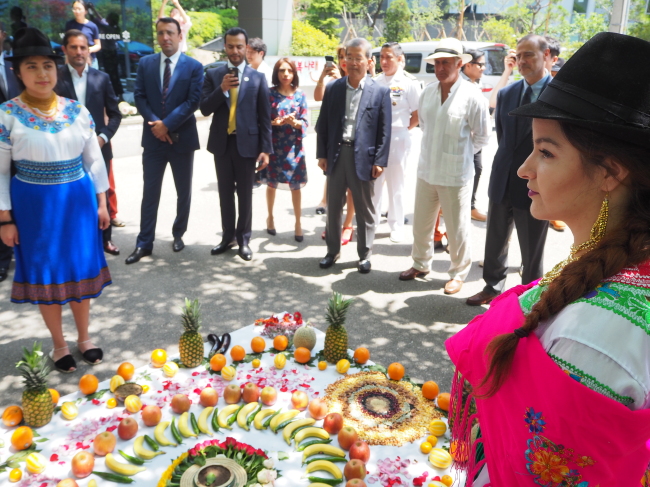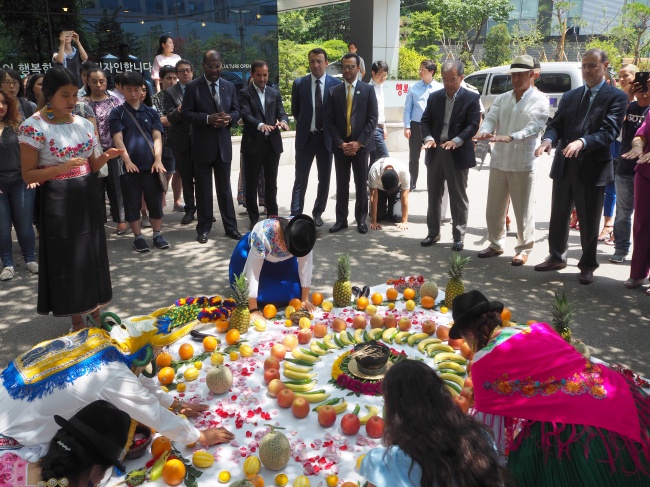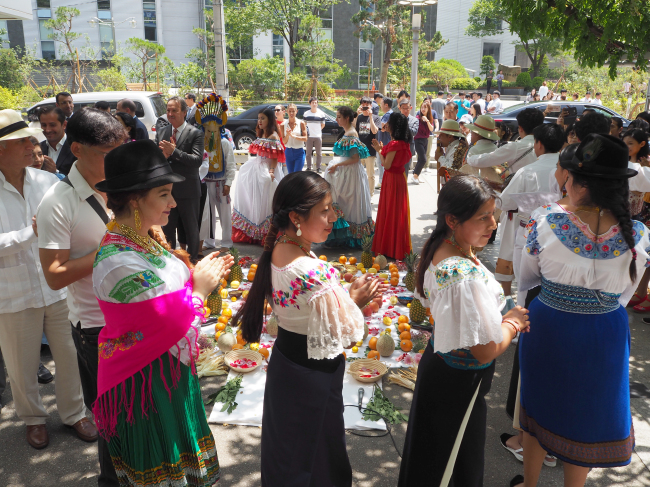People formed a ring encircling a “chacana” -- a space lavished with artfully juxtaposed fruits, grains and flower petals -- genuflecting, reaching out to the sky and expressing through mystical body language in a mimicry of a ritual leader donning a colorful mask.
The theatricals replicated the ceremony of “Inty Raymi,” or festival of the sun, the ancient Incan Empire’s essential rite of passage every year centered on the agricultural cycle and harvest.
The Ecuadorian Embassy, in collaboration with the World Culture Open, celebrated Inty Raymi in the heart of Seoul on Friday. A large crowd of people, including over 10 ambassadors and deputies, participated in the event and watched Ecuador’s traditional music and dance performed by its musicians and students.
 |
Foreign ambassadors and diplomats participate in an Inti Raymi celebration organized by the Ecuadorian Embassy and World Culture Open in Seoul on Friday. (Joel Lee/The Korea Herald) |
 |
Foreign ambassadors, diplomats and people reach out to the sky as part of an Inti Raymi celebration organized by the Ecuadorian Embassy and World Culture Open in Seoul on Friday. (Joel Lee/The Korea Herald) |
“On behalf of the Ecuadorian government, and with deep respect for our country’s ancient traditions, I have the honor to present the Inti Raymi celebration,” said Ecuadorian Ambassador to Korea Oscar Herrera Gilbert in a speech.
“Inti Raymi is the main tradition of our indigenous peoples, through which our ancestors and descendants have thanked ‘Pacha Mama,’ or Mother Earth, for their yearly harvests.”
With music, dance and gesturing guided by “Aya Huma,” the festivity’s main character, Ecuador’s indigenous communities have feted their harvests annually from June 17-23, he added.
The Incan ancients marked the heritage during this time of the year because the summer solstice, with the sun positioned farthest from the earth, creating the longest day, had a special significance for them. As part of the festival, the Incans would pray to their sun god Inti, and undertake rituals and dances to entreat the god to return and rekindle a new cycle of life.
 |
Performers genuflect as part of an Inti Raymi celebration organized by the Ecuadorian Embassy and World Culture Open in Seoul on Friday. (Joel Lee/The Korea Herald) |
 |
Foreign ambassadors, diplomats and people participate in an Inti Raymi celebration organized by the Ecuadorian Embassy and World Culture Open in Seoul on Friday. (Joel Lee/The Korea Herald) |
Today the custom is preserved in countries that were formerly home to the Incan Empire, the largest civilization in pre-Columbian America stretching from modern-day Mexico to Chile from the early 13th century through 1572.
People re-enacting Inti Raymi wear rainbow-colored attire and golden crowns. They, along with a beautiful sun princess, dance to the rhythmic beat of folkloric music, animating the ambiance with gaiety, gratitude and ancestral pride.
“Traditions and valuable inheritances as Inti Raymi must be defended, felt and relived through intercultural exchange such as our meeting today,” said Herrera Gilbert, who was wearing a white Ecuadorian hat. “We present a celebration that belongs to our people and history. Inti Raymi foments a true exchange of knowledge and identities.”
Chung Dal-ho, a director general of World Culture Open and the former South Korean ambassador to Panama and Egypt, said, “The world is not perfect and it will never be. But as long as we see each other without prejudice, embrace one another as we are and mutually offer what we have, we could keep alive our hope that the world is and can be better together.”
By Joel Lee (
joel@heraldcorp.com)











